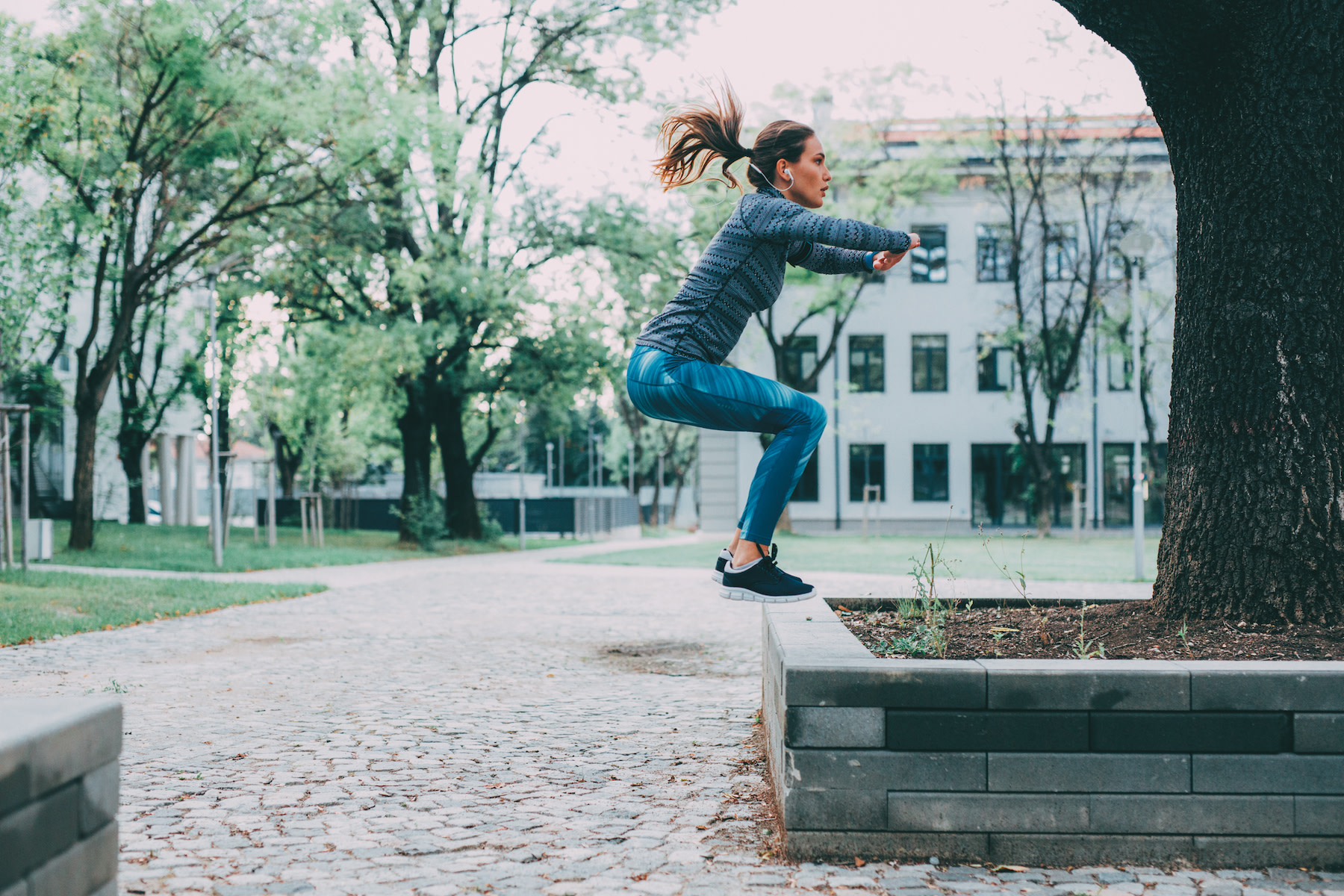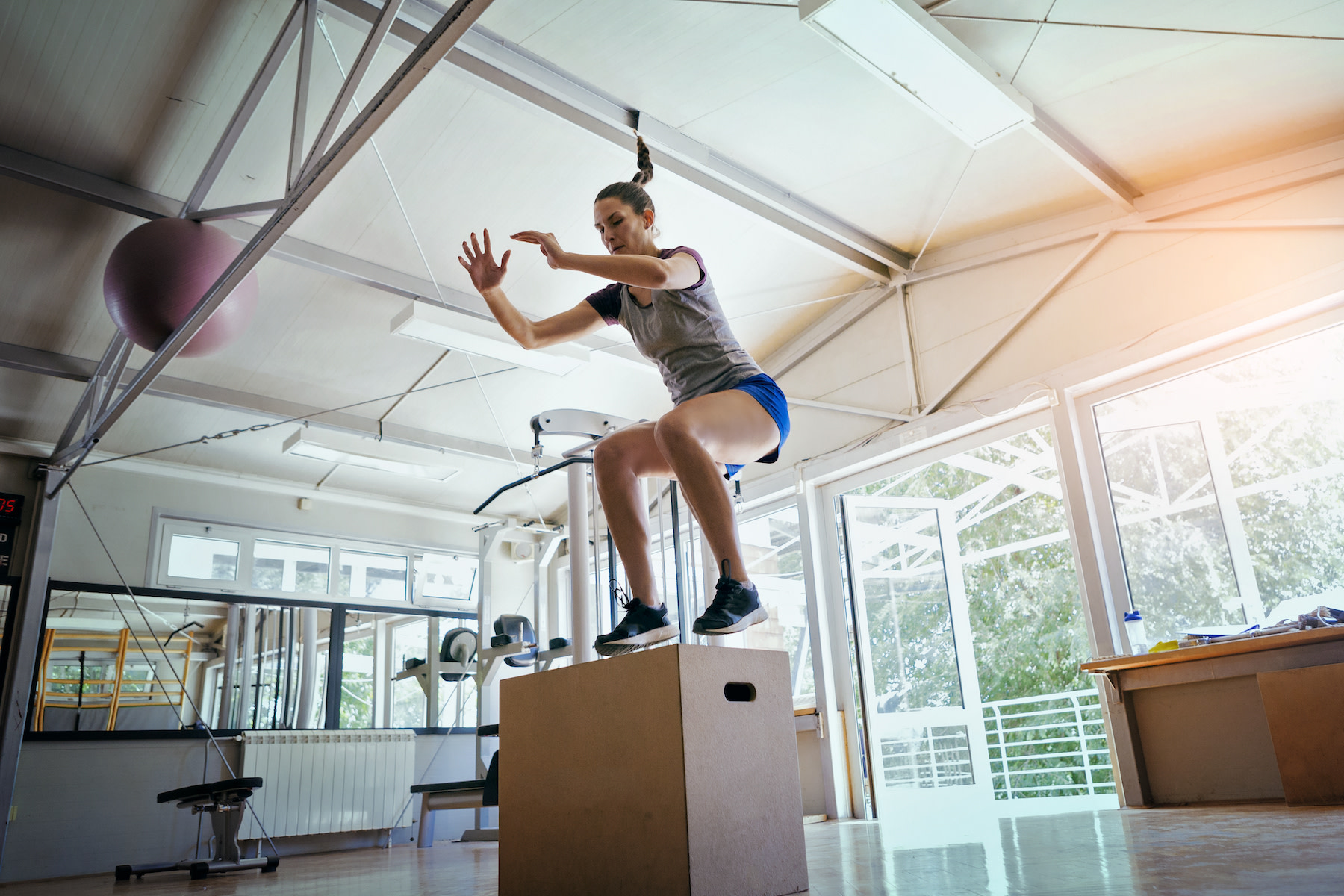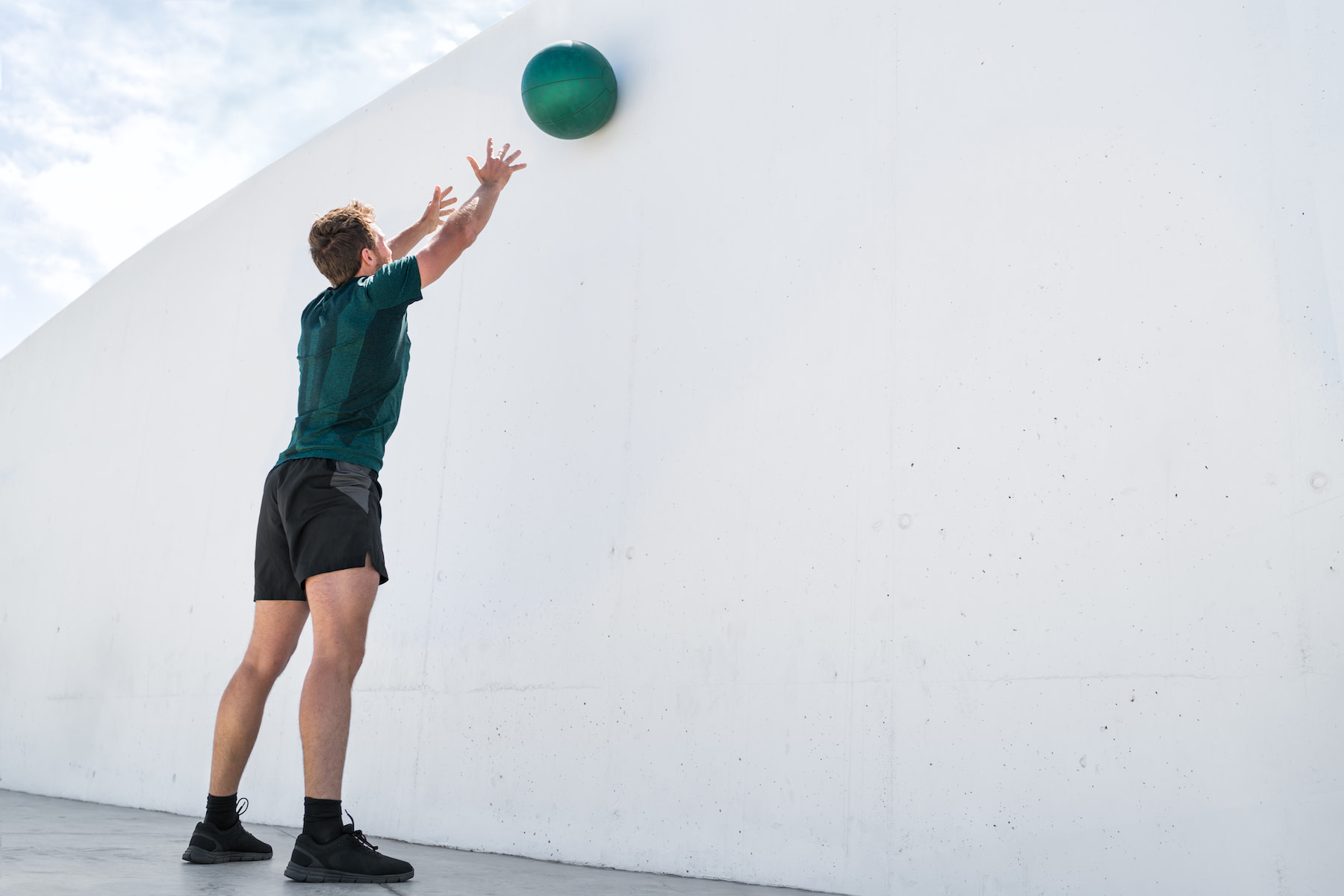
filadendron/E+ via Getty Images
Do You Need to Incorporate Plyometric Exercises Into Your Workout Regimen?
Experts break down what to know about these types of movements—and offer five to try.
By Eric Arnold•
What Are Plyometric Exercises?
What Are Fast-Twitch Muscle Fibers?
Is It OK to Do Plyometric Exercises Every Day?
The Benefits of Combining Plyometric Exercises with Strength Training
5 Plyometric Exercises to Try
Recently, after my first 45-minute Peloton Row Bootcamp class, I spent about five days hobbling around as if my leg muscles were on strike. The class included several lower body exercises, such as jump squats. I opted to hold a 25-pound weight for these movements.
“You used a 25-pound weight for your first plyometric exercises?,” an athletic friend asked me, his facial expression contorting with bewilderment. “You should have used no weights and worked your way up.”
Lesson learned—but at the time I had no idea what a plyometric exercise was. I’d never heard the term. Upon further exploration, I realized that these movements can be among the most beneficial exercises for increasing your speed and power—but only if you understand and engage with them properly. Therein lies the challenge: Plyometric exercises test your muscles as well as your restraint, since the natural athletic inclination in most of us is to push harder. But that tendency can have big drawbacks.
What Are Plyometric Exercises?
Think about an Olympic long jumper who needs to generate that perfect leap into the air. Or a thrower who needs to put everything into getting that javelin to the opposite end of the field. Plyometric exercises are what help you generate a moment of power, whether you’re pushing off the Row or getting your momentum going as you rise up from the saddle during a ride.
“Imagine yourself standing on a box, and you jump down onto the floor, bend your knees a bit, and then explode off the floor,” says Phillip Vardiman, an associate professor at Kansas State University who has a PhD in kinesiology. “The technical term is you have the eccentric, which is the lengthening, followed by a concentric contraction of the muscle.”
Achieving this explosive effort requires plyometric exercises—think box jumps or repeated hops on one foot up several flights of stairs. These movements are all about repeating the stretch and contraction of a particular group of muscles. “You’re trying to increase the load and the speed at which you do that activity,” says Vardiman, so when the time comes, you can generate that moment of power.
You can certainly expect to find your fair share of hops and jumps in bootcamp classes, or in full body strength workouts. What you probably won’t find, though, is a class dedicated exclusively to plyometric exercises—and with good reason.
“There are certain situations where individuals should approach plyometric exercises with caution or avoid them altogether,” says Peloton instructor Adrian Williams. “While plyometric exercises can be beneficial for improving athletic performance, they may not be suitable for beginners or individuals with limited fitness experience.” To understand why, you need to dive into the mechanics of your muscle fibers.
What Are Fast-Twitch Muscle Fibers?
We all have fast-twitch and slow-twitch muscle fibers in our bodies. Slow-twitch fibers provide you with stability, helping you maintain good posture or remain upright as you walk. Your fast-twitch fibers, by contrast, give you the ability to move in a quick, powerful way—be it a punch while boxing or that first moment when you start boosting your cadence in a ride. Your fast-twitch fibers enable the activities that require an intense burst, but they’re unable to sustain you for longer workout sessions.
Think of it this way: A sprinter running the 100-meter dash doesn’t need her fast-twitch fibers just for that initial sprint out of the blocks. The runner needs the ability to push with as much explosive power as possible for the entire length of the race—which lasts only 10 seconds, leaving her gassed at the finish.
Consider your goals. If running a fast 100-meter dash isn’t in your future, plyometric exercises might not need to be either. However, if approached sensibly, they can comprise a small—and beneficial—part of your overall training routine.
Is It OK to Do Plyometric Exercises Every Day?
No. Doing plyometric exercises on a daily basis can make you more susceptible to injury.
“Plyometric exercises can be added to a routine a few times a week, depending on your fitness level and goals,” Adrian says. “Start with one or two sessions per week and gradually increase as your strength and endurance improve—but it's essential to ensure proper form and technique to prevent injury and maximize benefits.”
Vardiman, who has worked with multiple Olympians and USA Track and Field, echoes that caution. “I’ve seen some very fit men, in particular, who did plyometric exercises and were very strong, and they had Achilles tears,” he says. “You have to make sure your body can handle the level of stress you put on it.”
There’s also a mental component. “You’re trying to shorten the amount of time it takes to cause that [muscle] contraction, which is very taxing on your neuromuscular system," he says. "You have to let your body recharge—at least 48 to 72 hours of rest between plyometric sets.”
And on the days you do plyometric work, make sure you’re warmed up and that you avoid heavy weight work, such as bench presses or squats. The two do not mix.
“Start with a foundation of basic strength training and gradually progress to more advanced exercises, which can help build the necessary strength and stability for plyometrics,” Adrian says. “They should make sense for the goal you're trying to accomplish.”
Related Articles

Cardio
Endurance Training Isn’t Just for Pro Athletes—Here Are 5 Ways to Get Started

Beginners
A Beginner’s Guide to the Gym: How to Feel Confident from Day 1

Strength Train
Peloton's Ultimate Guide to Strength Training for Beginners

Member News
Get the Exact Workouts Peloton Instructors Do IRL with Peloton Gym
The Benefits of Combining Plyometric Exercises with Strength Training
When you start incorporating plyometric workouts into your routine, expect to experience some soreness—and improvements to your performance. Unfortunately, the former will happen right away, and the latter will take some time.
“Plyometrics can enhance your athletic performance and boost your ability to generate force quickly, which may not be fully addressed by other types of exercises,” Adrian says. “Individual results may vary, but people often experience improvements [like] increased speed, agility, power, and vertical jump height."
Vardiman recalls seeing track and field athletes show up for their freshman year and recording dramatic improvements within their first few months by doing plyometric exercises. The sprinters run faster, the jumpers jump higher, and the throwers throw farther. But remember, these athletes have a full-time professional training staff around them. They follow a carefully coordinated, science-based training regimen. “If we jump in there and start doing too much, we won’t see the effects we should,” Vardiman says. With plyometrics, it’s all about working smarter, not harder.
5 Plyometric Exercises to Try
Before you try plyometric exercises, think about what you want to get better at and why having more fast-twitch muscle power will help. Once you've set your goals, you can dive into these types of movements. Here are five exercises Adrian recommends for improving your athletic performance:

Nastasic/E+ via Getty Images
1. Box Jumps
“These are great for developing explosive power in the legs,” Adrian says. “They target the quads, hamstrings, and glutes, helping to improve vertical jump height and overall lower body strength.”
How to do them:
Squat down, then leap with both legs onto an elevated surface, such as a large box that can support your weight.
Step back down to the ground.
Pause. Squat down and leap back up onto the box.
Repeat this as many times as you can before taking a break.
2. Depth Jumps
“This exercise helps improve reactive strength and the stretch-shortening cycle, which are crucial for explosive movements like sprinting and jumping,” Adrian says.
How to do them:
Start on an elevated platform and step down.
The instant both of your feet hit the ground, immediately jump as high in the air as you can, and land back on the ground.
Step back up onto the platform.
Repeat as many times as you can (bear in mind that this one is deceptively hard).

martin-dm/E+ via Getty Images
3. Bounding
“[This movement] helps improve coordination, stride length, and overall explosiveness,” Adrian says, “making it beneficial for athletes in sports like track and field or basketball.”
How to do it:
In this dynamic exercise, move through exaggerated, slow, powerful running strides.
Your feet should spring off the ground, and your knees should come as high in the air as possible—almost like exaggerated skipping.
Try to practice a set of 10 to 20 leaps before taking a break.
4. Plyometric Push-Ups
It can’t be understated: This one is hard. But Adrian says it’ll build strength and power in your chest, shoulder, and tricep muscles, improving both your upper body power and your speed.
How to do them:
Perform a regular push-up. However, with each push-up, try and spring your entire upper body high into the air.
If you’re really good at this, clap your hands in the air, then land on your palms again, and do another rep.
Repeat this as many times as you can.

Maridav/iStock / Getty Images Plus via Getty Images
5. Medicine Ball Throws
This is an exercise that pro golfers rely on for building swing velocity and power, but Adrian says it can also help improve coordination for any athletic activity.
How to do them:
Throw a weighted ball explosively against a wall or to a partner.
If you’re bouncing the ball off a wall, catch it, rotate your body away from the wall, then fling it back again.
Repeat this as many times as you can before taking a break.
There’s no sugarcoating it: Plyometric exercises are hard. If you don't approach them with caution and precision, they can result in a long, difficult road to recovery. But the patience that comes with starting slow and moving intentionally will pay off. “Never give up,” Adrian says, “because great things take time.”
Level up your cardio workouts
Enter your email to get articles, instructor tips, and updates from Peloton sent to your inbox.